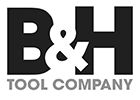Getting the most from your extrusion tooling.
To make this calculation, you’ll need to consider the physical constraints of the extrusion tooling and the rheological constraints of the polymer being extruded. Regarding the physical constraints of the head assembly, first determine the die’s largest possible ID opening. For our BH275C-1, for example, the die ID can be opened to a maximum of 1.75”. So, in calculating the tooling sizes for a tube with an optimal Area Drawdown Ratio (ADR) and Draw Ratio Balance,there is a ceiling of 1.75”. When you approach that limit, it’s time to consider variables, such as a lower ADR, a larger head assembly, slower line speeds, etc.
Regarding the rheological constraints of the polymer, the first step is to determine the optimal ADR for the specific material that you plan to extrude. For example, Flex PVC has an optimal ADR between 2:1 and 3:1. You need to stay within this range when calculating the tooling dimensions (e.g. Tip OD and Die ID). If you know the material you plan to extrude and the largest tube OD, one of our online calculators, located here, will be helpful.
The variables involved in determining the largest tube a particular head assembly can extrude include the polymer, the optimal ADR for that material, the maximum open die ID for that head assembly, and extrusion line speed. With this information, it is relatively easy to calculate the largest tube that can be extruded.
Several Operations Manuals are available with detailed recommendations. LINK
Look for tooling design for tubing in the Support: Briefs section TBD
To optimize extrusion tooling for a new or existing extrusion line, first consider flow path. For thermoplastics and fluoropolymers, the flow path within the head assembly must have a constantly converging flow path from the inlet port all the way out to the end of the die.
It’s important to avoid dead spots where material can get hung up as well as internal area expansion where material can expand. Since thermoplastics and fluoropolymers have elastic memory, any increase in internal volume will affect the dimensional stability at the exit of the die.
For sleeving applications, make sure to have the correct drawdown ratio and draw ratio balance for the material used with your extrusion tooling, as well as have a land that is appropriate for the die gap.
For pressure extrusions, it’s important to have an opening sufficient for the core to pass through, but not too big to allow leaking inside the tip. Sleeving tooling improves wall thickness control and pressure tooling is better for faster line speeds.
